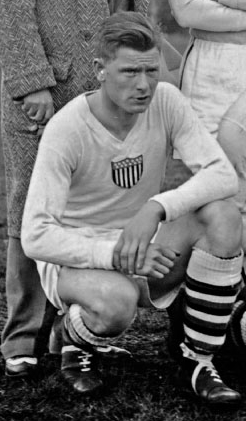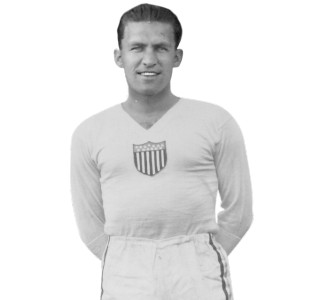Club career
Brown began his club career in 1950, playing with his father's amateur team, Greenport United, in the Connecticut State Amateur League, which his father had founded. In 1951, Greenport won the league title. In 1952, George signed with the New York Americans of the American Soccer League (ASL). However, the team released him due to his small size. He then signed with the New York German-Hungarians of the German American Soccer League (GASL) in 1953. At that time the German-Hungarians, although playing in a small regional league, boasted some of the top U.S. players, including John Souza, Walter Bahr and Joe Maca, all future members of the National Soccer Hall of Fame. This collection of talent paid off for the German-Hungarians as they took three consecutive league titles and the 1956 New York State Cup. In 1953, Brown was the league's MVP. As Brown proved himself in the GASL, the New York Americans tried to sign him but, having been turned down earlier, he refused. Instead, in 1957, he joined the Elizabeth Falcons, also known as the Polish Falcons, of the ASL. However, he tore the anterior cruciate ligament in his left knee during the season. Even with an injury shortened season, he led the ASL with thirteen goals. He began the 1957–1958 season, but was unable to play any significant time. With a professional career no longer possible, Brown was forced to look towards other fields.
Coaching
Brown gained his first coaching experience just after graduating from high school when he returned to coach his alma mater to a County Championship in 1955. Later, when an employee of Exxon, he coached youth soccer in Houston, Colorado and New Jersey. He also helped develop soccer associations in Houston and Colorado. After he retired, he and his wife operated tourist cottages in Nova Scotia. Brown continued to coach youth soccer, even in retirement and in 1993, he led the local Cabot Junior/Senior High School girls soccer team to the Provincial Championship.
Brown was inducted into the National Soccer Hall of Fame in 1995. [2] He and his father, Jim Brown, are the only father and son who have been inducted, as Players, into the Hall of Fame. Both he and George were also inducted into the Connecticut Soccer Hall of Fame and the New England Soccer Hall of Fame.
Bruce Edward Murray is an American former professional soccer player who at the time of his retirement was the all-time leading scorer for the United States men's national soccer team. His standout college career led to his selection by Soccer America Magazine to its College Team of the Century. He then played professionally in both Europe and the United States, including the American Soccer League and American Professional Soccer League. Concussion syndrome forced him to retire in 1995, Murray had earned 86 caps, scoring 21 goals, including one at the 1990 FIFA World Cup. He was also a member of the U.S. national futsal team which placed third at the 1989 FIFA Futsal World Championship. Murray is the Direct of Coaching at Accelerator School DC Metro. He is a member of the National Soccer Hall of Fame.

Bartholomew "Bertie" or "Bart" McGhee was a soccer player who played as a forward. Born in Scotland, he played for the United States national team at the 1930 FIFA World Cup and scored the second goal in World Cup history against Belgium. He was inducted into the U.S. National Soccer Hall of Fame in 1986.

James Brown was a soccer player who played for the United States men's national soccer team at the 1930 FIFA World Cup, scoring the only goal of the American team in their 6–1 semi-final loss to Argentina. He began his career in the American Soccer League before moving to England and then Scotland. After retiring from playing, he coached at the youth, senior amateur, and professional levels. He was inducted into the U.S. National Soccer Hall of Fame in 1986.
David "Davey" Brown was an American soccer forward. He spent most of his career playing for teams in New Jersey and New York, gaining his greatest fame with the New York Giants. He is a member of the National Soccer Hall of Fame.

Bernard "Benny" McLaughlin, Jr. was an American soccer forward who starred in the American Soccer League in the 1940s and 1950s. He earned twelve caps with the U.S. national team, was a member of the 1948 U.S. Olympic soccer team and was inducted into the National Soccer Hall of Fame in 1997.
Henry McCully is a retired Scottish-American soccer forward. A native of Scotland, McCully spent most of his career in the New England area of the United States. He earned two caps, scoring one goal, with the United States in 1975.
Efraín or Yeprem "Chico" Chacurian was an Argentine-American soccer forward. He earned four caps, scoring one goal, as a member of the U.S. national team in 1953 and 1954. He was inducted into the National Soccer Hall of Fame in 1992.
Charles Harry "Dick" Spalding was an American soccer and baseball player. He played the first two games in the history of the U.S. men's national soccer team and competed in professional soccer for nearly fifteen years, primarily with teams based in Pennsylvania. Besides, Spalding spent two seasons in Major League baseball and later served as a first base coach. A lifelong resident of Philadelphia, he was inducted into the National Soccer Hall of Fame in 1951.

George Moorhouse was the first native of England to appear in a FIFA World Cup. He spent most of his playing career in the United States and earned seven caps with the U.S. national team. He was a member of the U.S. teams at the 1930 FIFA World Cup and 1934 FIFA World Cup. Moorhouse was inducted into the National Soccer Hall of Fame in 1986.
John Hynes was a Scottish-born American soccer forward. He spent over twenty years in the American Soccer League, twice earning league MVP recognition. In 1949, he earned four caps with the United States men's national soccer team. In addition to playing professional soccer, Hynes was a New York City fireman from 1947 to 1975 and served in the U.S. Army in World War II. He is a member of the National Soccer Hall of Fame.

Gordon Bradley was an English-American soccer midfielder born and raised on Wearside who played several seasons with lower-division English clubs before moving to play in Canada at the age of 30. During the Canadian off-season, he played and coached in the U.S.-based German American Soccer League. In 1971, he became a player and head coach for the New York Cosmos. In addition to coaching the Cosmos, he has coached the U.S. national team and at the collegiate and high school levels. Bradley also earned one cap with the U.S. national team in 1973. He is a member of the National Soccer Hall of Fame.

Werner "Scotty" Nilsen was a former soccer player who played as a forward. He is one of the highest scoring players in United States soccer history, scoring 131 goals in 239 games with the Boston Soccer Club. He won five consecutive National Challenge Cups during his career, and four doubles. Born in Norway, he earned two caps with the United States national team in 1934. He is a member of the National Soccer Hall of Fame.
Alexandre "Alex" Ely was a Brazilian-American soccer midfielder, teacher and author. Ely played extensively in the U.S., Canada and Brazil winning multiple league and cup titles. He also earned four caps with the U.S. national team between 1960 and 1965. In addition to his extensive professional resume, Ely coached at the high school, collegiate and professional levels. He was inducted into the United States National Soccer Hall of Fame in 1997.
William Shamus O'Brien was an American-Scottish soccer inside left. During his Hall of Fame career, O'Brien spent eight seasons in the first American Soccer League and another five in the second American Soccer League.
Andy Stevens was an English-Canadian soccer center forward who began and ended his career in Canada but also spent six seasons in the American Soccer League. He was a two time league leading scorer with the ASL and was a member of the Canada Soccer Hall of Fame's 2006 Team of Distinction, the 1933 Toronto Scottish. In 2017, as part of the "Legends Class" he was elected to the Hall of Fame as an individual player.
Charles Edward "Teddy" Glover was a US soccer full back who began his career in the lower English divisions before playing several seasons in the American Soccer League. He is a member of the National Soccer Hall of Fame.
Ernő Schwarz or Schwarcz was a Hungarian American soccer player, coach and promoter who served as head coach of the United States men's national soccer team. He played professionally in Hungary, Czechoslovakia, Austria and the United States, earning two caps, scoring two goals, with the Hungarian national team in 1922. Schwarz founded, owned, managed and played for the New York Americans in the first and second American Soccer Leagues. He was also the ASL and International Soccer League vice president. His daughter was married to United States national team player Ben Zinn.
George Barr was an American soccer fullback who spent fifteen seasons in the American Soccer League. He was inducted to the National Soccer Hall of Fame in 1983.
Ronald Vernon Newman was an English professional association football player and coach. He was a member of the American National Soccer Hall of Fame.
Kurt Lamm was a German-born American soccer player, coach, manager, and administrator.







